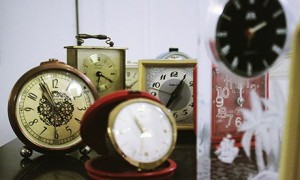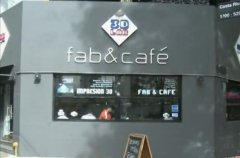A cafe that features start-ups and share sales time.

In London, England, a handmade cappuccino usually costs 26 yuan in a cafe.
London recently opened a bizarre Ziferblat cafe in a semi-secluded corner of the trendy Shoreditch district, where all coffee and refreshments are served for free, but it costs 10 cents an hour for every minute you stay. In other words, for 26 yuan, you can stay in the cafe for 88 minutes, nearly an hour and a half.
Here, you can play the piano, go to the automatic coffee machine to make yourself a cup of hot coffee, grab a few biscuits from the cupboard, and get a box of milk from the refrigerator-just as comfortable as in a friend's living room, except that you have to pay a few pennies.
It sounds like life in a collectivist commune, and yes, Ziferblat originated in Russia (the name means "clock surface") and has successfully opened ten stores in Russia and expanded to Ukraine.
Ivan Mitin, founder of Ziferblat, said: guests who come here usually line up to wash their used cutlery, and they even help clean the cups and saucers left by others, which makes them feel like a big family. He treats his guests as "mini tenants" of shared space.
Ivan Mitin, who loves literature, believes that this is "The Social Network in real Life"-bringing social networks on the Internet back to reality. People hold all kinds of activities (but no drinking) in cafes to create a community atmosphere, which satisfies people's little fantasies: to return to a carefree childhood, abandon the foolish norms of adult society, and be the id back to be loved unconditionally.
Many cafes try to copy the Ziferblat model, but just rent a space, equipped with a few pieces of cheap Ikea furniture, and then let guests pay on time-usually fail, if there is not the right atmosphere, just mechanically charge hourly fees, guests often feel boring and will not patronize.
As for the profit model, Mitin says that as long as core customers stay here long enough, they don't lose money, and cafes collect small donations from regulars from time to time, but in the final analysis, he sees it as a pro bono project rather than a business model.
At the end of the article, I can't help but ask a lot of questions. Can it work in a cafe like China? Can such a cafe make a profit? How should such a cafe be run? What if the guests can't make coffee? What if the guests are hungry for three days and then come back to spend? Will such an affordable place be overcrowded? Where should such a store be located? How to deal with crowd positioning? Is there any need for restrictions?
Even if I think a lot in the end, I still think this kind of cafe is worth learning and deliberating. Cafes that can't last can try it.
Friends who want to open a shop can try it if they want to try something new.
Finally, advice: friends who want to make money by opening a shop should not try. Because founder Mitin says: he sees this as a pro bono project, not a business model.
Important Notice :
前街咖啡 FrontStreet Coffee has moved to new addredd:
FrontStreet Coffee Address: 315,Donghua East Road,GuangZhou
Tel:020 38364473
- Prev

Experience 3D print themed Cafe
There is such a special cafe called 3D.LAR-fabcoffeebar on a street in Buenos Aires, Argentina. People come here not only for coffee, they all have a common hobby. They only come here to play 3D printing. I have to say that this is a unique coffee shop. This (3D.LAR-fabcoffeebar) cafe is Rod, an electronic engineer.
- Next

The first step in opening a restaurant is to make a creative menu for a cafe.
Opening a shop is the dream of many people, and the coffee shop is the first choice of many people, while there are so many cafes in the market, it is not easy to open a profitable coffee shop, and there are still a lot of things to prepare, such as interior decoration, style, what to sell, how much money to be prepared, whether to make money, how many shareholders, what technology, so much to do, to learn, to prepare, from where to go.
Related
- What documents do you need to go through to open a coffee shop? coffee shop coffee shop certificate processing process
- How to purchase Coffee beans in small Cafe how to choose a suitable supplier for domestic Coffee supply Company
- How to drink Starbucks Fragrance White Coffee? how to make Australian White Coffee? what Italian coffee beans are recommended?
- The Story of Flora Coffee: the name of Flora Coffee Bean and the implication of the Flowers on Florna Coffee
- How much does a cup of coffee cost? How much is the profit of a cup of coffee? What is the profit of the coffee shop in a year?
- Yunnan small Coffee, known as "fragrant Coffee", introduces the characteristics of Alpine Arabica Coffee producing areas in Yunnan, China
- 2023 latest Starbucks full menu price list how much is a cup of Starbucks coffee what is better to drink the most popular hot and cold drinks recommended
- Starbucks different kinds of Coffee Price list Starbucks menu 2023 Top Ten Best drinks in Starbucks
- Starbucks Spring praise Comprehensive matching Coffee Bean theme Story Packaging implication and taste description
- The cost of a cup of coffee latte American coffee cost price and selling price

